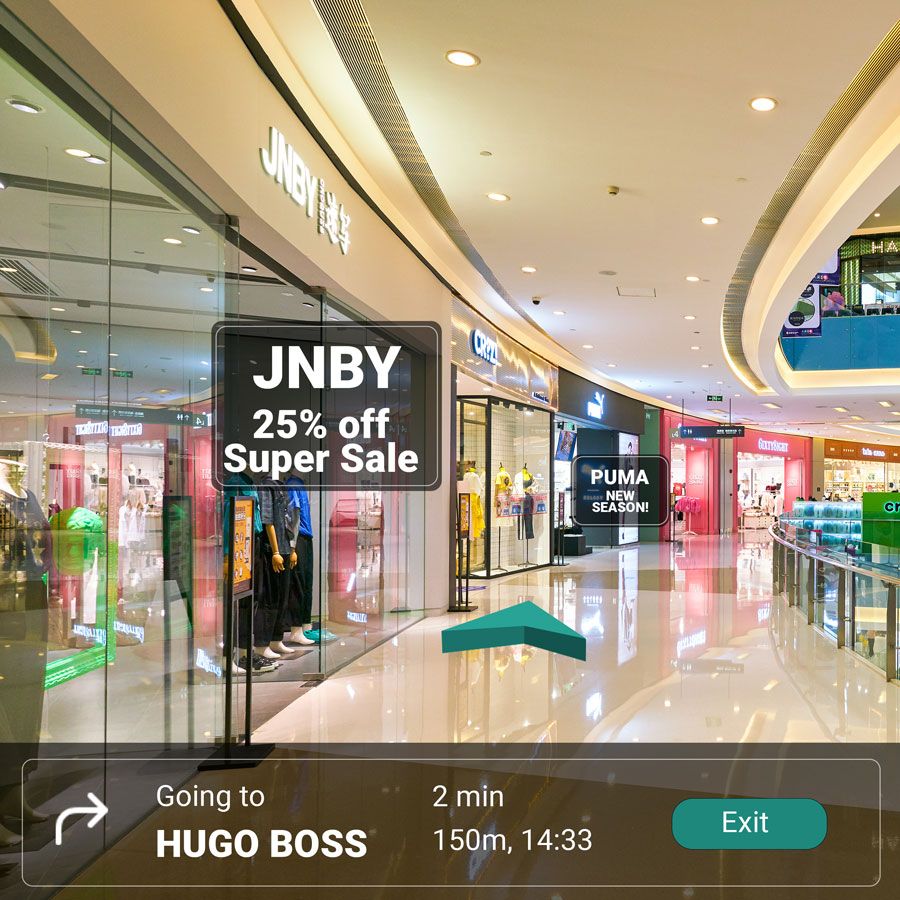Indoor Navigation Is Smarter — and It’s Augmented
Today's consumers, tenants, and guests expect a high level of digital convenience they experience online when navigating physical spaces.

Modern Wayfinding Solutions for Commercial Real Estate: From 2D Maps to AR Navigation
Commercial real estate properties are experiencing a fundamental shift in visitor expectations. Today's consumers, tenants, and guests expect the same level of digital convenience they experience online when navigating physical spaces. This evolution is driving property managers and CRE professionals to reconsider their approach to wayfinding and visitor navigation.
The Evolution of Indoor Navigation in Commercial Properties
Traditional wayfinding methods—static directories, printed maps, and basic signage—are no longer meeting the needs of modern commercial properties. Visitors expect intuitive, accessible, and personalized navigation experiences that help them efficiently reach their destinations while discovering relevant amenities and services along the way.
The challenge is particularly acute in complex environments like mixed-use developments, large shopping centers, business parks, and multi-building campuses where orientation can significantly impact the overall visitor experience.
Current Market Trends in CRE Wayfinding Technology
According to PwC's 2024 Global Consumer Insights Survey, 41% of consumers now expect digitally enhanced experiences in physical retail spaces. This expectation extends beyond retail to office environments, healthcare facilities, and public spaces.
The global augmented reality market is projected to surpass $50 billion by 2027, with navigation and location-based services representing one of the fastest-growing segments. This growth reflects the increasing adoption of AR technology in commercial real estate applications.
Properties across Asia and Europe are leading this transformation, with major shopping centers and business districts implementing smart navigation systems that provide real-time guidance and collect valuable visitor flow data.
Three Tiers of Modern Wayfinding Solutions
Interactive 2D Digital Maps
The foundation of modern wayfinding begins with interactive 2D mapping systems. These solutions replace static directory boards with dynamic, searchable interfaces that allow visitors to:
- Search for specific stores, offices, or amenities
- Get turn-by-turn directions to their destination
- Access real-time information about store hours and services
- View accessibility routes and facilities
Interactive 2D maps provide property managers with basic analytics on popular destinations and search queries, offering insights into visitor behavior and space utilization.

Immersive 3D Environmental Navigation
3D wayfinding solutions create comprehensive visual representations of complex spaces, helping visitors understand spatial relationships and navigate multi-level environments more effectively. These systems are particularly valuable for:
- Multi-story shopping centers and office buildings
- Campus-style business parks
- Mixed-use developments with varied zones
- Properties undergoing construction or renovation
3D navigation systems can display multiple floors simultaneously, show elevator and stair locations, and provide visual context that helps visitors orient themselves within the space.
AR-Powered Adaptive Navigation
Augmented reality represents the most advanced tier of wayfinding technology, using smartphone cameras and sensors to overlay digital guidance directly onto the real-world environment. AR navigation systems offer:
- Real-time visual guidance through camera-based directions
- Contextual information about nearby amenities and services
- Accessibility features including voice-guided navigation
- Personalized routing based on visitor preferences and needs
AR wayfinding can adapt to changing conditions, such as temporary closures or special events, providing dynamic routing that keeps visitors informed and efficiently guided to their destinations.

Benefits for Different CRE Property Types
Shopping Centers and Retail Properties
Modern wayfinding solutions help shopping centers improve visitor satisfaction and increase dwell time. Key benefits include:
- Enhanced discovery of new stores and promotions
- Improved navigation during busy periods and special events
- Better accessibility for visitors with mobility challenges
- Data-driven insights for optimizing tenant mix and layout
Business Parks and Office Complexes
For business parks and corporate campuses, smart wayfinding addresses common challenges:
- Efficient visitor and employee orientation
- Seamless navigation between multiple buildings
- Integration with meeting room booking systems
- Professional visitor experience that reflects corporate brand standards
Mixed-Use Developments
Mixed-use properties benefit from wayfinding solutions that can:
- Guide visitors between different functional areas (retail, office, residential)
- Provide contextual information about diverse amenities
- Support various user types with different navigation needs
- Create cohesive experiences across varied spaces
Unlock the ROI of Sustainable CRE Management
Discover how leading property owners achieved 27% energy reduction and boosted tenant engagement by 68% with an integrated ESG approach. Our case study reveals the strategies, tools, and metrics that transformed sustainability from a compliance challenge into a competitive advantage.
Download Case StudyImplementation Considerations for CRE Professionals
Technology Integration
Modern wayfinding platforms integrate with existing property management systems, providing centralized control and consistent user experiences. Key integration points include:
- Property management software
- Tenant directory systems
- Event management platforms
- Building automation systems
Data Analytics and Insights
Advanced wayfinding solutions provide valuable analytics that support strategic decision-making:
- Visitor flow patterns and peak usage times
- Popular destinations and underutilized areas
- Dwell time and engagement metrics
- Accessibility usage and effectiveness
Deployment and Maintenance
Successful wayfinding implementations require consideration of:
- Scalable deployment across multiple properties
- Regular content updates and maintenance
- Staff training and visitor education
- Integration with existing digital infrastructure
Boost Your Revenue with HyperIn
If you're ready to enhance your commercial real estate operations and unlock new revenue opportunities, get in touch with HyperIn today. Let's work together to step up your game!
Request More InformationHyperIn's Comprehensive Wayfinding Platform
HyperIn offers a complete wayfinding solution that spans all three tiers of navigation technology. Our platform provides:
Flexible Deployment Options: From basic 2D interactive maps to full AR navigation experiences, HyperIn's modular approach allows properties to implement solutions that match their specific needs and budget requirements.
Centralized Management: Property managers can control navigation content, promotional messaging, and system settings across multiple locations through a single dashboard.
Advanced Analytics: Comprehensive reporting tools provide insights into visitor behavior, space utilization, and navigation effectiveness, supporting data-driven property management decisions.
Seamless Integration: HyperIn's platform integrates with existing property management systems, ensuring smooth operation and consistent user experiences.
Future Outlook for CRE Wayfinding Technology
The wayfinding technology landscape continues to evolve, with emerging trends including:
- Enhanced accessibility features and compliance tools
- Integration with IoT sensors for real-time space monitoring
- AI-powered predictive navigation and crowd management
- Sustainability features including paperless communication and energy-efficient displays
As visitor expectations continue to rise and technology becomes more sophisticated, CRE properties that invest in modern wayfinding solutions position themselves to deliver superior visitor experiences while gaining valuable operational insights.
Conclusion
Modern wayfinding technology represents a strategic opportunity for commercial real estate professionals to enhance property value, improve visitor satisfaction, and gain competitive advantages in an increasingly digital marketplace. Whether implementing basic interactive maps or advanced AR navigation, the key is choosing solutions that align with property goals and visitor needs while providing the flexibility to evolve with changing technology and expectations.
The transition from traditional signage to smart navigation systems isn't just about keeping up with trends—it's about creating more efficient, accessible, and engaging spaces that meet the evolving needs of all property users.
Share This Article

Jean Carlos Delgado, Brand and Marketing director and staff writer at HyperIn, covering topics related to retail real estate management and technology. He's the author, most recently, Data Sharing - The Currency of Trust in Commercial Real Estate.






